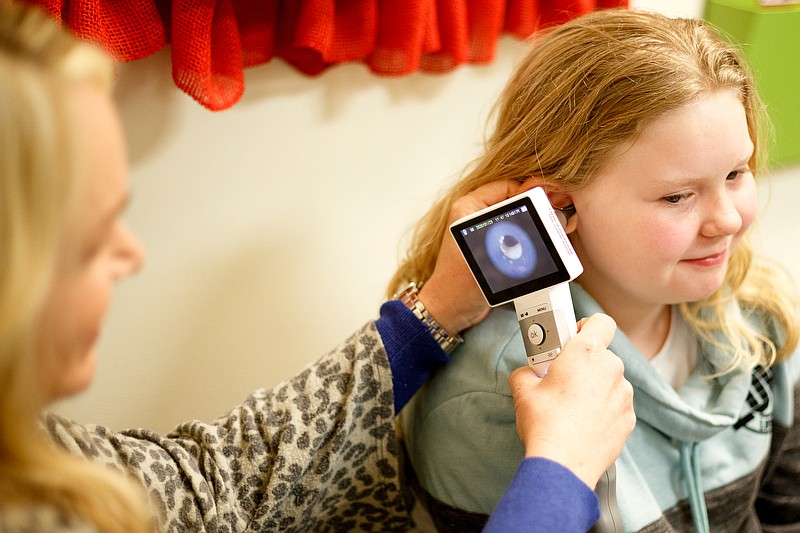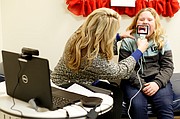PIKEVILLE, Tenn. - Two years ago, a young student came to the nurse's office at Mary V. Walker Elementary School in Bledsoe County with a high fever and body aches. All signs pointed to the flu as the virus swept through schools across the region.
"You could tell he felt terrible," said Michelle DeBord-Rains, the school health coordinator and nursing supervisor for Bledsoe County Schools.
She wanted to send him home, but that's not always easy in a small mountain town. Although the area has more medical providers than some other rural counties in the state, DeBord-Rains said geographic, economic and transportation barriers often pose challenges to getting students the care they need.
The county seat, Pikeville, sits in the middle of the picturesque Sequatchie Valley, flanked by the Cumberland Plateau and Walden Ridge. But because of the terrain and sparse population, it takes some students an hour-and-a-half bus ride to get to school, she said. Many parents also commute to larger cities for work or don't have transportation, which was the case with her sick student that day.
"His mother was very concerned but simply had no transportation or family to assist," DeBord-Rains said. So, her only option was to put a mask on the student, let him sleep in the office and send him home on a school bus, but she knew there had to be a better way.
Telemedicine, also called telehealth, provides long-distance clinical health care using electronic information and telecommunication technologies. It often focuses on populations with barriers to care, such as rural communities, those living in poverty or people who are homebound. Studies show that when used properly to assist school nurses, telehealth can reduce communicable disease outbreaks, help manage chronic conditions, improve student attendance, and enhance work productivity of staff and parents, according to the National Association of School Nurses website.
DeBord-Rains learned that other schools in surrounding counties were using telemedicine services through Chattanooga-based Erlanger Health System. The technology allows school nurses to communicate with nurse practitioners stationed inside a mobile medical clinic in Bradley County - the hub of Erlanger's school telemedicine program - two counties over. Ronald McDonald House Charities of Greater Chattanooga, the Lyndhurst Foundation, other donations and grants provided the funds to start and sustain the program.
Equipment costs $10,000 per school, and Erlanger finances the effort through philanthropy and grants at no cost to the schools. If a student has health insurance, Erlanger uses that to cover the cost of a virtual visit. Grant funds now cover appointments for those without insurance, but often Erlanger is able to help those children and their families enroll in TennCare.
The Bledsoe County School Board voted to implement the program in its five schools starting August 2019. Since then, 75 students, faculty and staff members have received care through the service.
If a student comes to the nurse's office with symptoms that warrant telehealth - fever, sore throat, congestion - the school calls their guardian and asks if they want a visit or to take the child to their regular provider. Head injuries, physicals, complicated infections, cuts that require stitches, traumatic injuries and serious illnesses are not able to be treated.
Visits typically happen within 10 to 15 minutes, last about as long and are conducted by a trained nurse in communication with an Erlanger nurse practitioner, who watches through a webcam. Many times, the parent joins in via phone.
BY THE NUMBERS
Bledsoe County / TennesseeRural: 100.0% / 33.6%Primary care doctors: 14,680:1 / 1,390:1Children in poverty: 30% / 21%Flu vaccinations: 34% / 48%Source: 2019 County Health Rankings
Although they can't draw blood, the school nurse is able to test for flu, strep throat and urinary tract infections. The technology also allows the school nurse to share pictures of the inner ear, nose or throat with the practitioner and parents, and a digital stethoscope lets the practitioner hear heart and lung sounds in real time. After the visit, the nurse practitioner calls the parent to go over the diagnosis and is able to call in prescriptions to the pharmacy if they're needed. That way, parents can pick the medicine up on their way home.
"We're finding that students return back to school quicker, because they're getting treated faster, and they're not having to miss school when it's non-contagious," DeBord-Rains said.
In addition to fewer student absences, 52% of teachers treated through the program are able to return immediately to class because they're not infectious. As a result, students keep their primary educator, and the school saves money on substitute teachers, which cost $65 per day, according to DeBord-Rains.
One challenge has been getting parents to submit the consent forms needed to conduct a visit. She suspects parents were afraid the school would treat their children without their knowledge, but things are improving now that parents are learning more about the program.
"We never do a visit without calling home first, even if we have that consent form," she said. "We'll call home and say, 'Hey, they've got these symptoms. Do you want to take them to your primary care doctor, or would you like us to do a telemed visit?' If they say telemed visit, then we're ready to go."
Bledsoe County Director of Schools Jennifer Terry said this year's chronic absentee numbers are "way down," and she thinks a big reason is because of the preventive care and access to health care now available in the school.
"It goes back to treating the whole child. Being in a rural area, the school is such a hub for everything," Terry said. "This was a way to help folks get a resource in our district, because a lot of folks don't have access."
In addition to Bledsoe County, the service is now in Grundy, Sequatchie, Meigs and Bradley County schools, as well as Cleveland City Schools. Sharon Hart, the telehealth manager for Erlanger Children's Hospital, said schools have the most success with the program when they have buy-in from leadership and school nurses, because "it takes a village to do this."
"There's a lot of moving parts," Hart said. One of the biggest criticisms of telemedicine is that it can lead to more fragmented medical care, but Hart said Erlanger sends all records of the visits to the students' primary providers, and this program does not replace them.
"We try to build the medical home. We want kids to be seen by their primary care doctor," she said.
Hamilton County Schools had a pilot version of the program during the 2016-2017 school year. While it was popular with nurses in the schools, district spokesman Tim Hensley said in an emailed statement that the program ended primarily due to administrative issues.
Although the problem was corrected, some families incorrectly received bills for the free service as Erlanger worked through technical issues with new electronic medical record software. Hensley said the program also struggled due to the size of the more urban district and a larger non-English speaking population.
Don Mueller, CEO of the Children's Hospital at Erlanger, said they also received pushback from local pediatricians who felt the service would poach their patients.
"We were not warmly received by the community, for whatever reason," Mueller said, adding that talks about future re-expansion remain positive.
Bledsoe County is fortunate because its school board funds school nurses beyond the state minimum, bringing its school nursing force up from one to five, DeBord-Rains said. She's able to cover the telemedicine visits in the valley, so the nurses at those three schools never have to leave their posts, and a trained nurse at each of the two schools on the mountains handles those campuses.
"If we didn't have that support, we would not nearly be as successful as we are, because on a typical day for Laura [the Pikeville Elementary School nurse], she would never have the time to sit down and do a telemedicine visit," she said.
There are 1,600 students in Bledsoe County, and the school nurses average 15,000 total student encounters per year, according to district data.
Matthew Shafer, Erlanger's administrative director of telemedicine, said working with the schools has opened his eyes to how many hats school nurses wear, particularly in rural communities.
"I see kids literally just pouring into their office, and they give advice, education. Many schools give clothes away to these kids, gas, and I had no idea they were doing all this until I started visiting," Shafer said. "They are like the frontline health care provider for thousands of kids."
DeBord-Rains said her primary goal is to remove whatever barriers keep a student from being healthy and successful. Just last week, she treated a middle school boy with pinkeye.
"He sort of put his head down and said, "My mom could not leave work yesterday to take me to the doctor. She would've been fired. But, she sent this back,'" she recalled. Then he handed her a piece of crumpled-up paper.
"It was a consent form."
Contact Elizabeth Fite at efite@timesfreepress.com or 423-757-6673.

